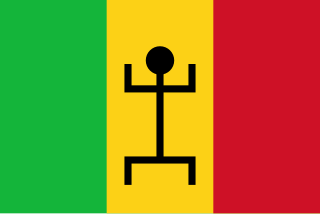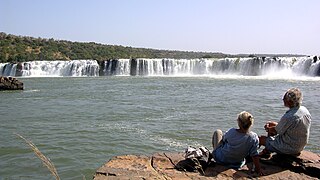This article relies largely or entirely on a single source .(December 2015) |
This article relies largely or entirely on a single source .(December 2015) |
It is served by a station on the Dakar-Niger Railway.

Kayes is a city in western Mali on the Sénégal River with a population of 127,368 at the 2009 census. Kayes is the capital of the administrative region of the same name. The name "Kayes" comes from the Soninké word "karré", which describes a low humid place that floods in rainy season. The city is located 420 kilometres (260 mi) northwest of the capital Bamako.

The Mali Federation was a federation in West Africa linking the French colonies of Senegal and the Sudanese Republic for two months in 1960. It was founded on 4 April 1959 as a territory with self-rule within the French Community and became independent after negotiations with France on 20 June 1960. Two months later, on 19 August 1960, the Sudanese Republic leaders in the Mali Federation mobilized the army, and Senegal leaders in the federation retaliated by mobilizing the gendarmerie ; this resulted in a tense stand-off, and led to the withdrawal from the federation by Senegal the next day. The Sudanese Republic officials resisted this dissolution, cut off diplomatic relations with Senegal, and defiantly changed the name of their country to Mali. For the brief existence of the Mali Federation, the premier was Modibo Keïta, who would later become the first President of Mali, and its government was based in Dakar, the eventual capital of Senegal.

Thiès is the third largest city in Senegal with a population officially estimated at 320,000 in 2005. It lies 72 km (45 mi) east of Dakar on the N2 road and at the junction of railway lines to Dakar, Bamako and St-Louis. It is the capital of Thiès Region and is a major industrial city.

The Falémé River is a river in West Africa. The Falémé arises in northern Guinea and flows in a north-northeast direction to Mali, forming a short portion of the border between Guinea and Senegal. It turns north and then forms a portion of the border between Mali and Senegal, before joining the Sénégal River 50 km upstream of the town of Bakel in Senegal.

The Dakar–Niger Railway connects Dakar, Senegal to Koulikoro, Mali. The name refers to the Niger River, not the Republic of Niger. It serves many cities in Senegal, including Thiès, and in Mali, including Kayes, Kita, Kati, Bamako. The line covers a course of 1,287 km of which 641 km lies in Mali.
The Lytton First Nation, a First Nations band government, has its headquarters at Lytton in the Fraser Canyon region of the Canadian province of British Columbia. While it is the largest of all Nlaka'pamux bands, unlike all other governments of the Nlaka'pamux (Thompson) people, it is not a member of any of the three Nlaka'pamux tribal councils, which are the Nicola Tribal Association, the Fraser Canyon Indian Administration and the Nlaka'pamux Nation Tribal Council.
The Tŝideldel First Nation is the band government of the Tsi Del Del subgroup of the Tsilhqot'in people, located in the Chilcotin District in the western Central Interior region of the Canadian province of British Columbia. It is a member of the Tsilhqot'in National Government.
Bofal is a small town in southern Mauritania. There are phosphate deposits in the vicinity. It lies near the southern border formed by the Senegal River
List of Railway stations in Senegal include:
Railway stations in Mali include:
Aere Mbar is a town and commune in the Brakna Region of south-western Mauritania. It is located near the border with Senegal.
Goudiry is the chief town and commune of the department of Goudiry in the region of Tambacounda in the east of Senegal. The town has a population of approximately 7000.
The Hartley Bay Indian Band is also known as the Gitga'at First Nation or the Hartley Bay First Nation. The members of the Gitga'at First nation are often referred to as Gitka'a'ata. The population of Gitk’a’ata peoples living in Hartley Bay ranges from approximately 130-200 people. There are also about 400-500 Gitk’a’ata peoples living in Prince Rupert, British Columbia, Canada, a neighboring territory. The Gitk’a’ata people have lived in Hartley Bay for hundreds of years, if not always. Some notable things regarding the Gitga'at First Nation are their economy, geography, government, sports involvement, COVID-19 regulations, and relations.
Koussanar is a town in central Senegal in Tambacounda Department, center of an arrondissement.

The Gouina Falls or Chutes de Gouina are on the Sénégal River in Mali between the towns of Bafoulabé (upstream) and Diamou (downstream) in the Kayes Region, where the river runs north from the Talari Gorges. They have been called the "Niagara falls of Mali". The river is about 500 m wide at this point, and drops 16 m over the falls. The volume of water is 12-13 m3 per second in the dry season, and up to 2430 m3 per second in the rainy season.
Bososo is a town in Eastern Region, southern Ghana.
Mali has one railroad, including 729 kilometers in Mali, which runs from the port of Koulikoro via Bamako to the border with Senegal and continues on to Dakar. The Bamako-Dakar line, which has been described as dilapidated, was owned by a joint company established by Mali and Senegal in 1995, with the eventual goal of privatization. In 2003 the two countries sold a 25-year concession to run the rail line to a Canadian company, which has pledged to upgrade equipment and infrastructure.
Bhimsen is a village in Kanpur district in the state of Uttar Pradesh, India.
Awtano is a member of the Fakaofo island group of Tokelau.

SM UB-114 was a German Type UB III submarine or U-boat in the German Imperial Navy during World War I. She was commissioned into the German Imperial Navy on 4 May 1918 as SM UB-114.
14°25′00″N12°12′00″W / 14.41667°N 12.20000°W